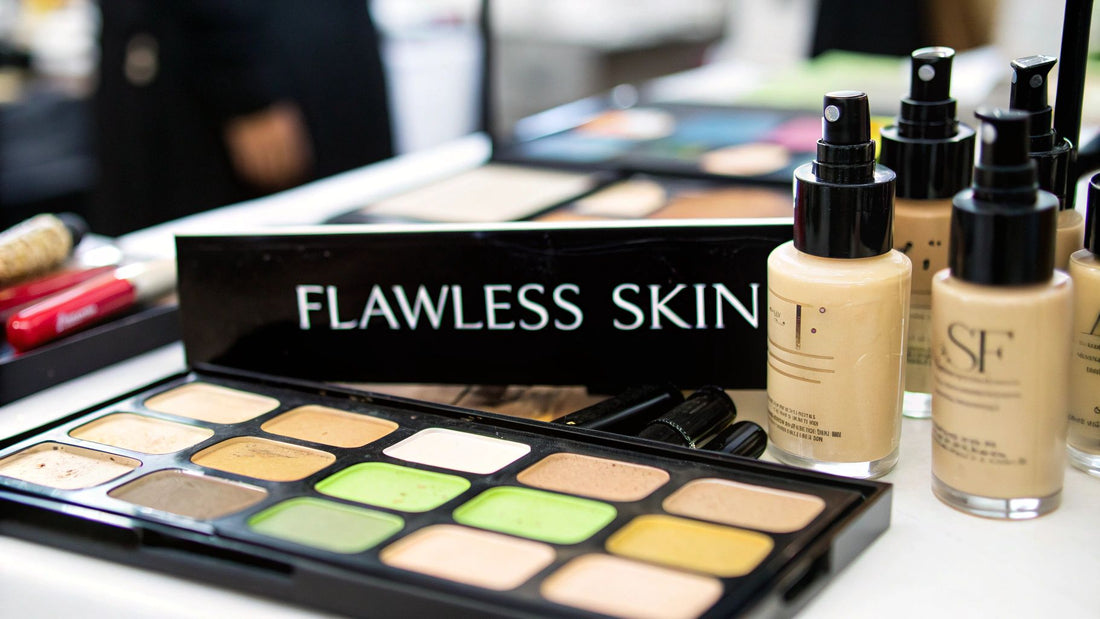Picking the right foundation really comes down to a few key things: figuring out your skin's undertone, matching the formula to your specific skin type, and deciding on the coverage you actually want. Once you nail these, you'll find a foundation that looks and feels like a second skin, no matter what the Canadian weather throws at you.
Your Guide to Finding the Perfect Foundation Match
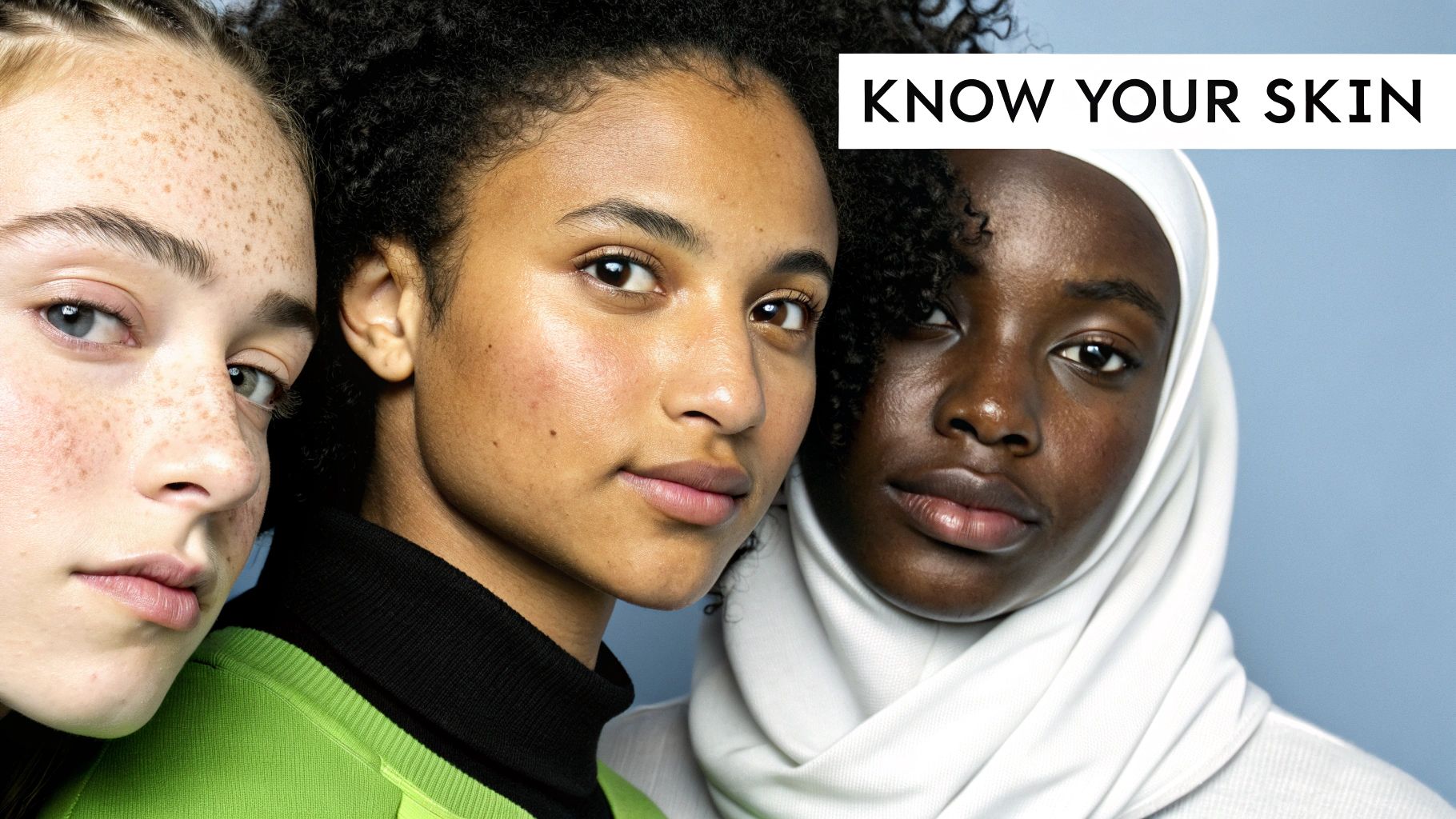
Let’s be honest, hunting for the perfect foundation can feel overwhelming. Get it right, though, and it's the secret weapon for a truly flawless makeup look. Think of this guide as your personal roadmap, designed with the Canadian beauty lover in mind. We're here to cut through the noise and give you practical, real-world advice to help you finally understand what your skin needs.
We’ll walk through how to pinpoint your undertone, choose the right coverage level for you, and find formulas that hold up beautifully in our country's wild climates—from those dry prairie winters to humid Toronto summers. This is your first real step toward discovering a foundation you'll absolutely love.
Why Getting the Foundation Right is a Game-Changer
The right foundation does so much more than just cover up spots; it creates a smooth, even canvas that can be a huge confidence booster. When you get the match right, your makeup looks effortless and natural, lasts all day, and truly enhances your features. A bad match? It's just frustrating and can make your whole look feel off.
It's no surprise that the demand for better, more sophisticated formulas has created a huge market. The global foundation industry was valued at a staggering USD 10.5 billion in 2023 and is expected to climb to USD 18.8 billion by 2033. This boom is happening because Canadians are more aware of what we're putting on our skin, demanding formulas that now do double duty with benefits like hydration and sun protection.
This is especially true if you have specific skin concerns. For example, finding the best foundation for aging skin means looking for hydrating ingredients and lightweight formulas that won't settle into fine lines.
A great foundation should be your secret. The goal isn’t to look like you’re wearing a mask of makeup, but to look like you just have incredible skin. It’s that one product that can instantly even out your complexion and set the stage for everything else.
To make things a little easier, here's a quick cheat sheet to point you in the right direction based on your skin type and what you're trying to achieve.
Foundation Finder Quick Guide
| Skin Type | Recommended Foundation Type | Best For |
|---|---|---|
| Oily / Combination | Matte or Oil-Free Liquid/Powder | Controlling shine and long-lasting wear |
| Dry / Dehydrated | Hydrating Liquid or Cream | A dewy, luminous finish that won't cling to dry patches |
| Mature Skin | Serum or Luminous Liquid | Smoothing fine lines and adding a youthful glow |
| Sensitive Skin | Mineral or Fragrance-Free | Minimizing irritation and providing gentle coverage |
This table is a great starting point, but remember that personal preference plays a huge role. Don't be afraid to experiment to find what feels best on your skin.
Finally Decode Your Skin's True Undertone
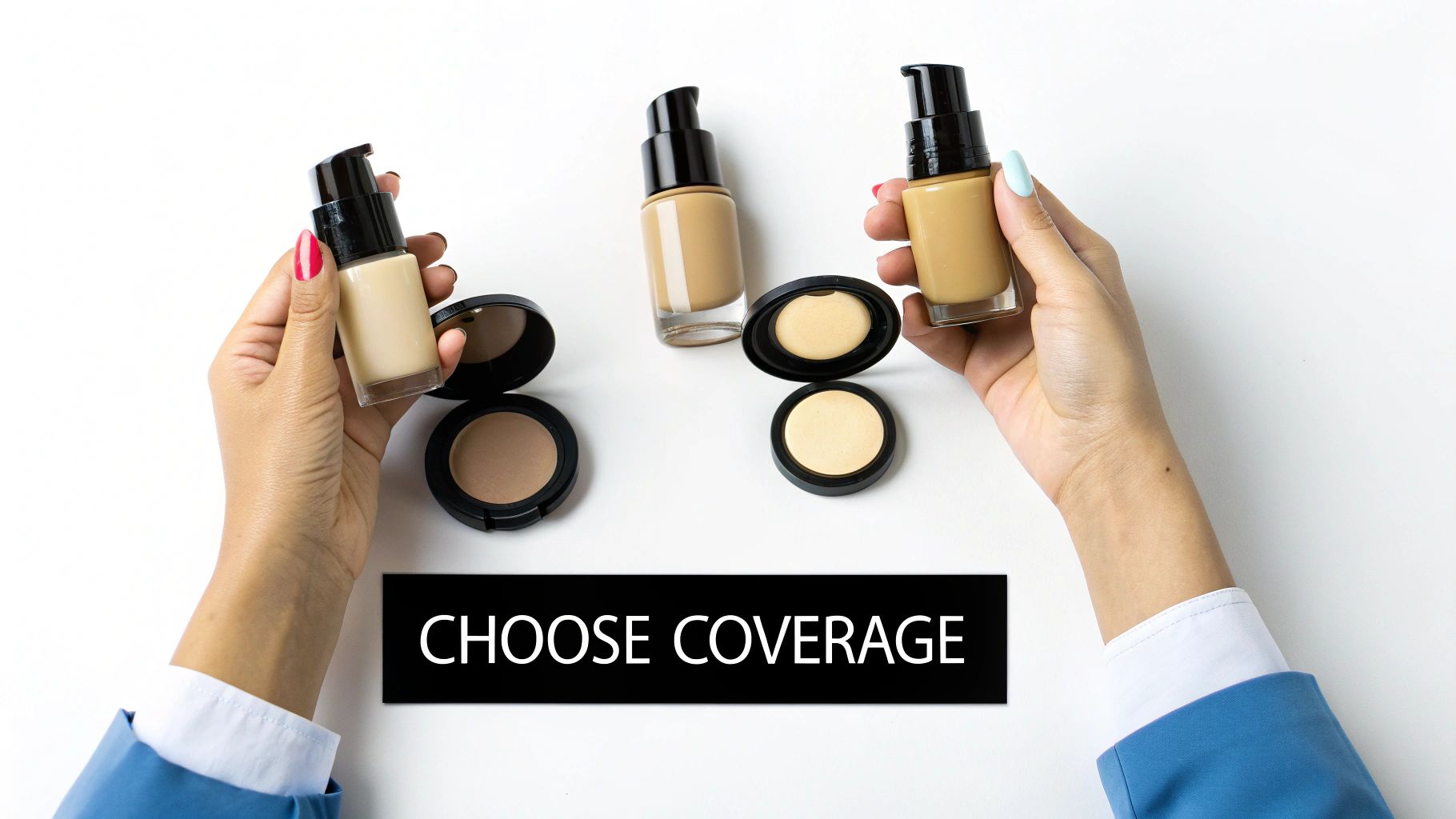
Have you ever bought a foundation that looked perfect in the store, only to step outside and realize it’s turned strangely orange or ashy? We’ve all been there. This common frustration usually boils down to one thing: getting the undertone wrong. Nailing this is the secret to a truly seamless match.
Your skin's surface tone—what you might call fair, tan, or deep—can shift with sun exposure, even during a Canadian summer. But your undertone is the permanent, subtle hue just beneath the surface. It's the one thing that never changes, and it’s what makes a foundation look like a second skin instead of a mask.
Simple Tricks to Find Your Undertone
You don't need a professional eye to figure this out. A couple of quick at-home tests are all it takes to see if you lean cool, warm, or neutral.
-
Check Your Veins: Take a look at the veins on the inside of your wrist in natural light. If they look distinctly blue or purple, you likely have cool undertones. If they appear more greenish, you’re in the warm undertone family. See a bit of both or can’t really tell? You’re probably neutral.
-
The Jewelry Trick: Which metals make your skin pop? If silver and platinum give you a vibrant, healthy glow, you're likely cool-toned. But if gold is what really brings your complexion to life, you’re warm-toned. And if you can rock both without a problem? Lucky you—you’re neutral.
My Biggest Tip: The fluorescent lighting in stores like Shoppers Drug Mart or Sephora is notoriously deceptive. Before you commit to a shade, find a window or, even better, step outside for a moment. Natural daylight doesn't lie, and it will show you the foundation's true color.
Putting Your Undertone to Work
Once you know your undertone, shopping for foundation gets so much easier. You’ll start noticing that brands often label their shades with a C for Cool, W for Warm, or N for Neutral. Suddenly, shade names like "Light-Medium Neutral" or "Tan Warm" make perfect sense.
This knowledge is your best defense against a foundation that oxidizes and turns orange (a classic sign of a warm shade on cool skin) or one that makes you look ashen.
Formulas are getting smarter, too. New innovations are helping foundations adapt even better to your unique skin. You can learn more about how biomimic technology revolutionizes foundation and what it means for finding a perfect match. Ultimately, understanding your undertone is about choosing a foundation with confidence, saving you time, money, and a lot of frustration.
Match Your Foundation Formula to Your Skin Type
Choosing the right foundation formula really comes down to listening to your skin. A product that gives one person a gorgeous, dewy glow might be a greasy mess on someone else by lunchtime. The texture, the finish, and the ingredients are what make or break how a foundation performs throughout the day, especially with Canada’s wild weather swings.
Think about it: a rich, hydrating cream foundation can be a godsend during a brutal Calgary winter. But that same product would be a nightmare in the middle of a humid Montreal summer. That’s when you’d reach for something long-wearing and matte. Nailing this match is the secret to makeup that looks incredible and feels like nothing at all.
Decoding Formulas for Oily and Combination Skin
If you're constantly battling shine, your mission is to find a foundation that keeps oil in check without making your skin look dull or heavy. Oil-free liquids and powders are going to be your best friends. These formulas are specifically designed to soak up excess oil, often with powerhouse ingredients like silica or kaolin clay to maintain a soft, matte look.
A lightweight liquid with a natural matte or satin finish is often the perfect balance, giving you coverage that doesn't feel like a mask. Powder foundations are also brilliant, especially for on-the-go touch-ups, and you can easily build up the coverage where you need it. Just remember to prep your skin well—you don't want powder clinging to any rogue dry spots.
Nourishing Choices for Dry and Mature Skin
When your skin is on the drier side, hydration is non-negotiable. You want to look for formulas that bring back that luminous, plump look. Your best bets are cream foundations, hydrating liquids, and the newer serum foundations.
These are usually loaded with skin-loving ingredients. When you're reading labels, keep an eye out for these heroes:
- Hyaluronic Acid: This is a superstar hydrator that pulls moisture into the skin, giving it a plumper, smoother appearance.
- Glycerin: Another fantastic moisturizer that helps protect your skin’s natural barrier.
- Niacinamide: This ingredient is a true multi-tasker, helping to even out skin tone and refine texture with continued use.
These ingredients are key because they stop the foundation from settling into fine lines or clinging to dry patches. And for mature skin, what’s underneath is just as important. Creating a smooth, hydrated canvas is everything, and you can learn more about finding the best moisturizer for aging skin to get it right.
This chart is a great little cheat sheet for figuring out your skin's undertone, which as we've discussed, is another huge piece of the puzzle.
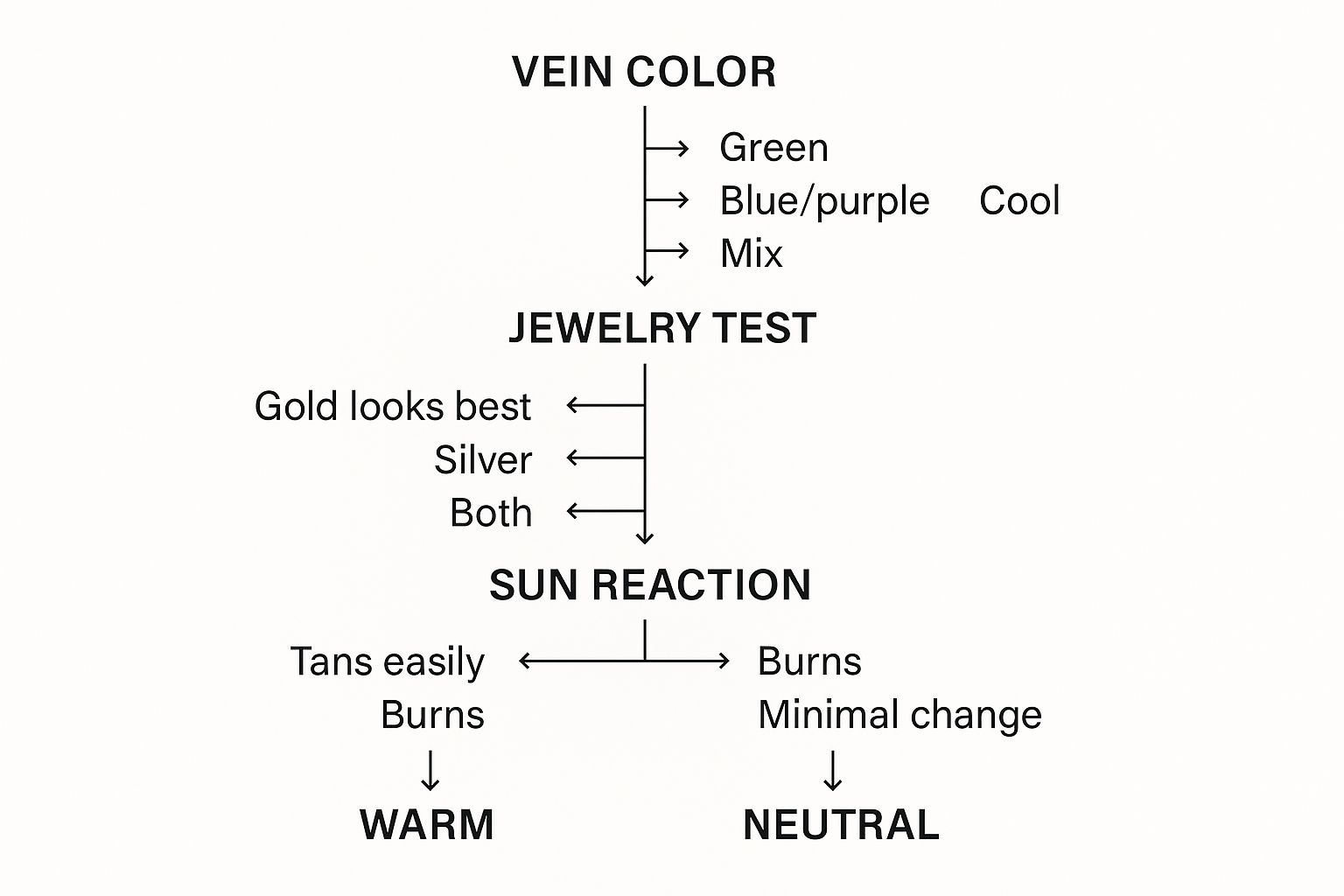
Simple visual cues, like the color of your veins or how your skin tans (or burns!), are surprisingly effective ways to confirm if you lean warm, cool, or neutral.
Nail Your Coverage and Finish for Any Vibe
Okay, so you've nailed your perfect shade. What's next? It's all about deciding on the coverage and finish. This is where you really get to control the final look, taking your makeup from a barely-there, natural feel to a totally flawless, photo-ready complexion. Honestly, it’s less about hard rules and more about matching your foundation to your skin's mood and the occasion.
Think of coverage as how much of your natural skin you want to see. Are you letting your freckles say hello, or are you aiming for a completely uniform canvas for a big event? The finish is the texture—how the light plays off your skin.
Finding Your Coverage Sweet Spot
Foundation coverage usually comes in a few main flavors. Most Canadians I know, myself included, keep a couple of different types on hand because our social calendars and the weather can be so unpredictable.
- Sheer to Light Coverage: This is your weekend warrior, your "my skin but way better" secret weapon. It’s perfect for just dialing down a bit of redness without feeling like you're wearing makeup at all. Picture a tinted moisturizer for a casual brunch in Kitsilano.
- Medium Coverage: This is the MVP of foundations for a reason. Medium coverage is incredibly versatile because you can build it up. A single, light layer works for the office, but you can easily add a bit more to hide a surprise blemish or some hyperpigmentation.
- Full Coverage: Save this one for the big moments. When you need a completely polished, airbrushed look that will not budge, full coverage is your best friend. It's what you reach for before a wedding, a photoshoot, or any time you need your makeup to be bulletproof.
Here's a pro tip I swear by: to build coverage without it ever looking heavy or cakey, use a damp beauty sponge. Instead of wiping, press and bounce the foundation onto your skin in very thin layers. Focus just on the areas that need a little extra love. This technique really melts the product in for a seamless, second-skin effect.
Picking a Finish That Flatters
The finish is what gives your skin its final look and feel once the foundation sets. It can be the difference between a youthful glow and a chic, velvety texture.
- Dewy/Radiant: This finish is a game-changer for anyone with dry or mature skin. It imparts a luminous, hydrated glow that reflects light beautifully, which has the added bonus of softening the look of fine lines. For anyone navigating foundation for mature complexions, a radiant finish is often the holy grail. You can dive deeper into this with our guide on the best foundation for mature skin.
- Satin/Natural: If you're ever unsure, go with a satin finish. It’s the perfect middle ground—not too shiny, not too flat, it just looks like healthy, happy skin. It’s a universally flattering choice that works for nearly everyone, any time.
- Matte: For my fellow Canadians with oily or combination skin, a matte finish is your secret to staying shine-free. It helps absorb excess oil and gives you a modern, polished look that will last all day, even through a humid Toronto summer afternoon.
The Smart Way to Test and Sample Foundation
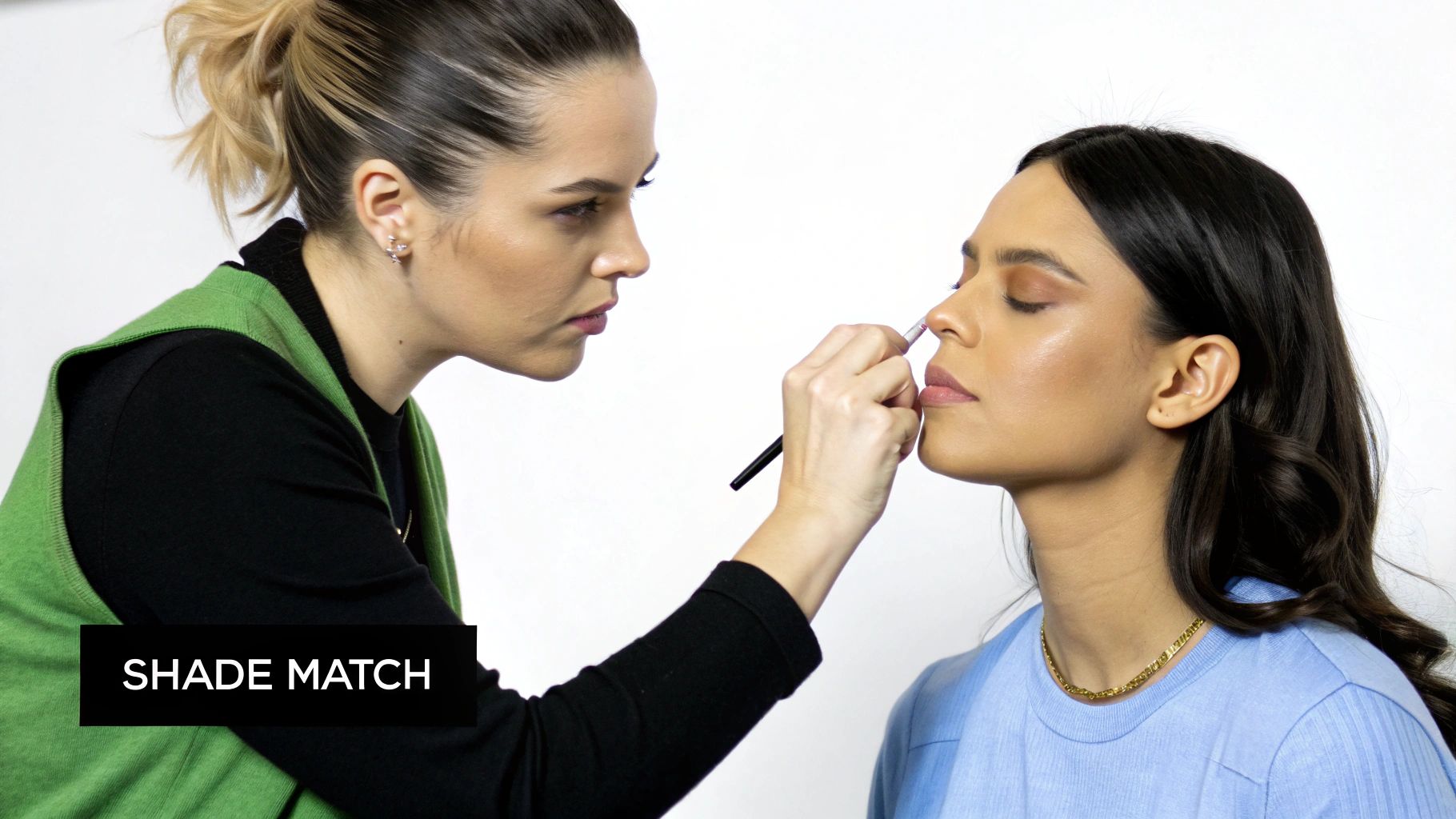
If I can give you one golden rule for foundation shopping, it’s this: always test before you buy. I know it's tempting to grab and go, but this one simple habit is your best defense against a drawer full of expensive mistakes.
And where you test is just as important as the test itself. Please, stop swatching on your hand or wrist! The skin there has a completely different tone and texture than your face.
The only real way to know is to apply a few potential shades directly along your jawline. This spot is the perfect place to see if a colour will truly disappear, blending seamlessly from your face to your neck for that invisible match we're all after.
Take It for a Real-World Test Drive
Don't ever feel shy about asking for samples. Whether you're at Sephora or Hudson's Bay, the staff are there to help you find the right match. Getting a small pot of foundation to take home is the ultimate try-before-you-buy.
Why? Because it lets you wear the foundation for a full day to see how it really performs in your life, not just under harsh store lighting.
A full-day trial is the only way to check for two crucial deal-breakers:
- Oxidation: Does the shade deepen and turn an unflattering orange after a few hours? This is a common issue as the pigment reacts with your skin's natural oils.
- Longevity: How does it hold up through a busy day? Does it settle into fine lines, get patchy, or just fade away by lunchtime?
A foundation can look absolutely flawless for the first five minutes. Its true character only comes out after hours of wear. A full-day test shows you exactly how it interacts with your skin and handles the day, saving you from a disappointing purchase.
While you're testing, take a peek at the formula's ingredients. If your skin is sensitive or prone to breakouts, look for hypoallergenic and non-comedogenic options. It’s no surprise that natural ingredients now make up 15-20% of recent foundation launches—we all want cleaner, safer makeup. You can learn about the cosmetic industry's safety innovations to feel even more confident in your choice.
Once you’ve finally found the one, mastering the application is the final piece of the puzzle. For expert tips on making your perfect foundation last, you’ll want to read our guide on how to make makeup stay on all day.
We Answer Your Final Foundation Questions
You've done the research, you've narrowed down your choices, but there are always those one or two nagging questions that pop up just as you're about to commit. Let's tackle those last-minute uncertainties head-on. These are the most common questions we hear, with answers tailored for the Canadian beauty scene.
What About When My Skin Tone Changes with the Seasons?
This is a classic Canadian dilemma. Your perfect winter shade looks ghostly against your summer glow, but buying two full bottles feels wasteful. The pro trick? Don't buy a whole new foundation.
Instead, grab the exact same formula you love, just a shade or two darker. This becomes your secret weapon. You can mix a tiny drop into your regular foundation to create a custom shade that adapts perfectly as your tan builds and fades. It’s far more economical and gives you a flawless match all year round.
How Do I Handle a Tricky-to-Match Undertone?
Some skin tones, especially olive or very fair complexions, just don't fit neatly into standard shade ranges. If you constantly find foundations pulling too orange or too pink, it's time to play chemist.
Colour-correcting drops are a game-changer. A little bit of a blue pigment can instantly neutralize a foundation that's too warm or orange. Similarly, a touch of yellow can correct a shade that looks too pink or rosy. It feels a bit like being an artist, but it's the single best way to create a truly bespoke shade that looks like it was made just for you.
The real secret to that flawless, I'm-not-wearing-makeup look? It’s not just the product; it's how you put it on. Always, always start with less than you think you need. You can build coverage where you need it—like around the nose or over areas of redness—without masking your entire complexion.
How Can I Get That Airbrushed Finish?
That coveted, seamless finish comes down to your tools. The right applicator makes all the difference between a foundation that sits on your skin and one that becomes one with it.
- A damp beauty sponge: This is your best friend for a natural, second-skin effect. The bouncing or "stippling" motion presses the product into your skin, melting it in seamlessly.
- A dense buffing brush: For a bit more coverage and a beautifully blended result, use a buffing brush. Work in small, circular motions to buff the foundation out, leaving zero streaks behind.
Nailing these final details is what separates a good makeup day from a great one. It gives you the power to not only choose the right foundation but to apply it with the confidence of a pro.
Ready to find a foundation that truly looks and feels like your own skin, only better? Discover the collection at PriPedi, thoughtfully created with mature skin in mind.
Visit us at https://www.pripedi.com to find your perfect match today.

